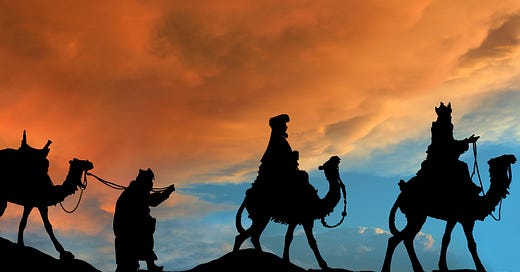Three Kings’ Day: A Lesser-Known Yet Significant Filipino Tradition
Discover how the spirit of Epiphany is kept alive in Filipino Culture.
The Magi: Gaspar , Melchior, and Balthasar
As you may have read previously, for the entire duration of the ‘Ber months (i.e. September, October, November, and December), the Philippines celebrate Christmas.
But we’ll let you in on a little secret: In January, the party doesn’t stop.
Observed on January 6, the Feast of the Epiphany, also known as Three Kings’ Day, commemorates the visit of the Magi (or the three wise men) to the infant Jesus. The religious significance of this event is that, in the visit of the Magi, who come from lands far away, Christ’s presence is made manifest not just to His own people, but to the rest of the world also.
In essence, Three Kings’ Day is a celebration of religious unity as well as cultural diversity - and so it is very fitting that in the Philippines, the feast is marked by unique practices and festive activities that vary by ethnic group and province.
Historical and Religious Context
The Epiphany traces its origins to the Gospel of Matthew, where the Magi followed a star to Bethlehem to offer gifts of gold, frankincense, and myrrh to the newborn Jesus. In the Philippines, the celebration of Three Kings' Day is closely tied to the country’s history of Spanish colonization. Catholicism was introduced to the islands in the 16th century, and with it came the observance of the liturgical calendar, including the Feast of the Epiphany.
Known locally as “Araw ng Tatlong Hari”, the day marks the end of the Christmas season in the Philippines. It is a time for reflecting on faith, expressing gratitude, and participating in communal festivities.
While the core of the Epiphany centers on religious observance, its celebration takes on regional flavors, shaped by local customs and traditions.
Urban and Parish Celebrations
In urban areas, particularly in Metro Manila, the Epiphany is often celebrated with special Masses dedicated to the Magi. Churches are adorned with images of the three kings, and processions are held to honor their journey. Some parishes organize reenactments of the Magi’s visit, with participants dressed as the wise men, bearing symbolic gifts.
The tradition of gift-giving extends to the home, where families exchange presents to symbolize the gifts of the Magi. In some areas, children place their shoes outside the house, hoping that the “three kings” will leave treats or small tokens overnight, similar to Christmas stockings.
Pampanga: Festive Parades
In the province of Pampanga, known for its vibrant Christmas traditions, the Epiphany is celebrated with grand parades featuring colorful floats depicting the Magi and nativity scenes. This region’s deep devotion to Catholicism is evident in its elaborate decorations and the enthusiastic participation of local communities. The parades are often accompanied by street performances, music, and traditional dances, turning the event into a public spectacle of faith and joy.
Cebu: Sinulog Prelude
In Cebu, the Epiphany serves as a prelude to the Sinulog Festival, one of the country’s most famous religious events in honor of the Santo Niño (Holy Child). During this time, families visit churches to pray and offer flowers to the Santo Niño, drawing a connection between the infant Jesus and the gifts brought by the Magi. Although Sinulog itself peaks in mid-January, the spirit of the festival begins to build around the time of the Epiphany, with early preparations and community gatherings.
Ilocos: The Star-Lantern Tradition
In the Ilocos region, the Epiphany is intertwined with the tradition of making and displaying “parols” or star-shaped lanterns. These lanterns symbolize the star that guided the Magi to Bethlehem and remain lit in many households and churches until January 6. The final lighting of the parols often coincides with evening prayers or a family feast, emphasizing the role of the Magi as bearers of light and hope.
Mindanao: Multicultural Influences
In Mindanao, where Christian and Muslim communities coexist, the celebration of the Epiphany often takes on a more inclusive tone. While primarily a Christian observance, the day is marked by community gatherings where neighbors of different faiths share meals and exchange greetings. This practice underscores the spirit of unity and sharing that the Magi’s journey represents.
Food and Festive Feasts
Food plays a central role in Filipino celebrations, and the Epiphany is no exception. Traditional dishes such as lechon (roast pig), pancit (noodles), and kakanin (rice cakes) are often served during family gatherings. In some regions, “Rosca de Reyes,” a sweet bread ring popular in Spain and Latin America, has been adapted into local variations, reflecting the country’s colonial heritage.
Modern Adaptations
While traditional practices remain strong, modern influences have introduced new ways of celebrating the Epiphany. In recent years, some communities have incorporated contemporary elements such as themed parties, online novenas, and social media campaigns promoting the values of generosity and faith associated with the Magi.
The Feast Continues
The celebration of the Epiphany in the Philippines is a vivid tapestry of faith, history, and culture. From solemn church services to festive parades and family feasts, the day reflects the enduring significance of the Magi’s journey in the lives of Filipinos.
As the country continues to balance tradition and modernity, the Epiphany remains a cherished reminder of the values of faith, unity, and gratitude that lie at the heart of Filipino culture.





